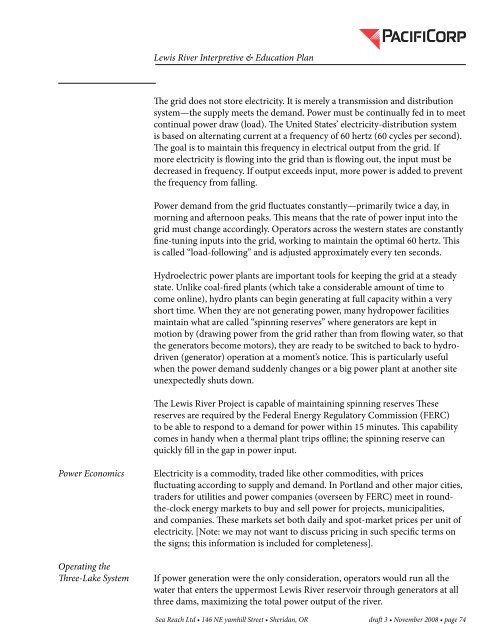The Lewis River Hydroelectric Projects - PacifiCorp
The Lewis River Hydroelectric Projects - PacifiCorp
The Lewis River Hydroelectric Projects - PacifiCorp
Create successful ePaper yourself
Turn your PDF publications into a flip-book with our unique Google optimized e-Paper software.
<strong>Lewis</strong> <strong>River</strong> Interpretive & Education Plan<br />
<strong>The</strong> grid does not store electricity. It is merely a transmission and distribution<br />
system—the supply meets the demand. Power must be continually fed in to meet<br />
continual power draw (load). <strong>The</strong> United States’ electricity-distribution system<br />
is based on alternating current at a frequency of 60 hertz (60 cycles per second).<br />
<strong>The</strong> goal is to maintain this frequency in electrical output from the grid. If<br />
more electricity is flowing into the grid than is flowing out, the input must be<br />
decreased in frequency. If output exceeds input, more power is added to prevent<br />
the frequency from falling.<br />
Power demand from the grid fluctuates constantly—primarily twice a day, in<br />
morning and afternoon peaks. This means that the rate of power input into the<br />
grid must change accordingly. Operators across the western states are constantly<br />
fine-tuning inputs into the grid, working to maintain the optimal 60 hertz. This<br />
is called “load-following” and is adjusted approximately every ten seconds.<br />
<strong>Hydroelectric</strong> power plants are important tools for keeping the grid at a steady<br />
state. Unlike coal-fired plants (which take a considerable amount of time to<br />
come online), hydro plants can begin generating at full capacity within a very<br />
short time. When they are not generating power, many hydropower facilities<br />
maintain what are called “spinning reserves” where generators are kept in<br />
motion by (drawing power from the grid rather than from flowing water, so that<br />
the generators become motors), they are ready to be switched to back to hydrodriven<br />
(generator) operation at a moment’s notice. This is particularly useful<br />
when the power demand suddenly changes or a big power plant at another site<br />
unexpectedly shuts down.<br />
<strong>The</strong> <strong>Lewis</strong> <strong>River</strong> Project is capable of maintaining spinning reserves <strong>The</strong>se<br />
reserves are required by the Federal Energy Regulatory Commission (FERC)<br />
to be able to respond to a demand for power within 15 minutes. This capability<br />
comes in handy when a thermal plant trips offline; the spinning reserve can<br />
quickly fill in the gap in power input.<br />
Power Economics<br />
Operating the<br />
Three-Lake System<br />
Electricity is a commodity, traded like other commodities, with prices<br />
fluctuating according to supply and demand. In Portland and other major cities,<br />
traders for utilities and power companies (overseen by FERC) meet in roundthe-clock<br />
energy markets to buy and sell power for projects, municipalities,<br />
and companies. <strong>The</strong>se markets set both daily and spot-market prices per unit of<br />
electricity. [Note: we may not want to discuss pricing in such specific terms on<br />
the signs; this information is included for completeness].<br />
If power generation were the only consideration, operators would run all the<br />
water that enters the uppermost <strong>Lewis</strong> <strong>River</strong> reservoir through generators at all<br />
three dams, maximizing the total power output of the river.<br />
Sea Reach Ltd • 146 NE yamhill Street • Sheridan, OR draft 3 • November 2008 • page 74
















